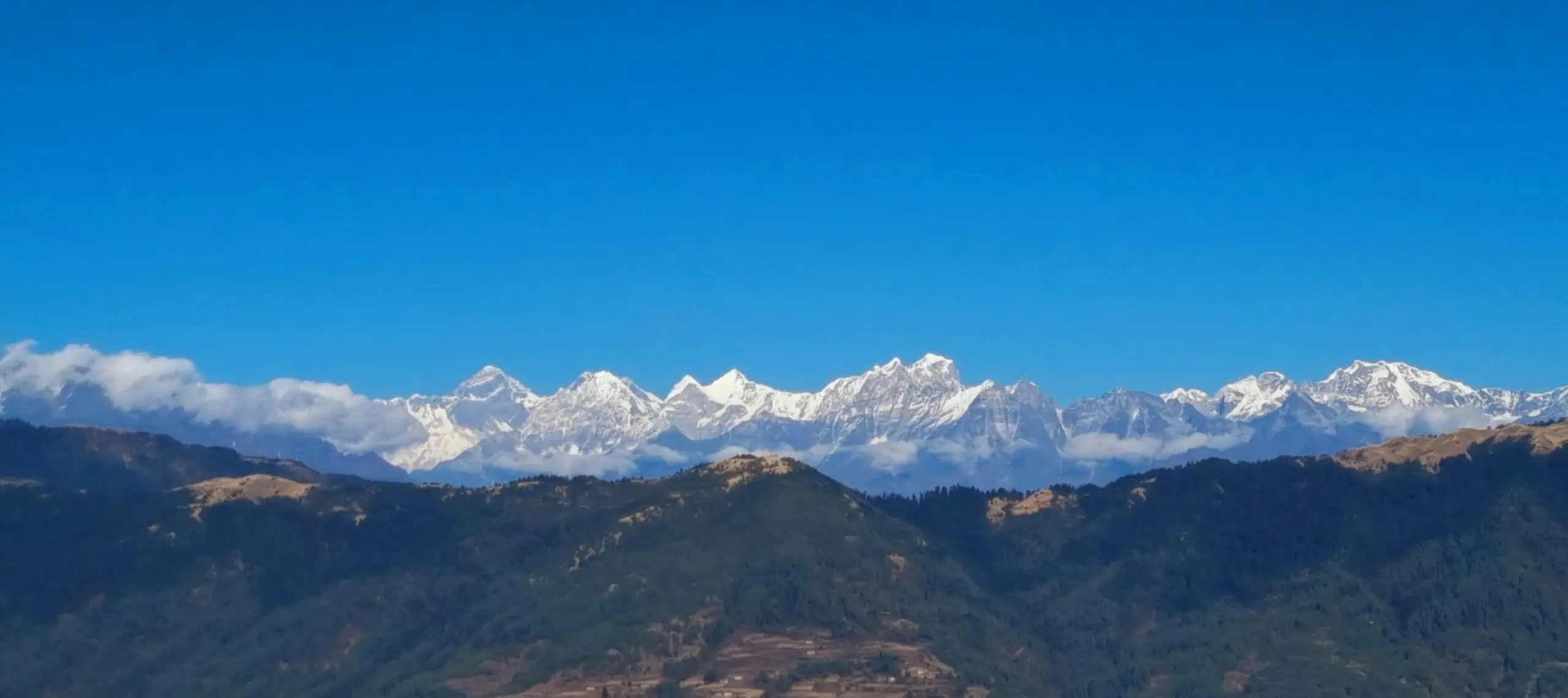
Pisang Peak Climbing 19 days
USD 2,590
USD 2,490 per person
| Activities | - | Fitness Level | strenuous |
| Max Elevation | 6091m | Commute | Kathmandu to Beshishahar |
| Best Month | March-May, September-December | Group Size | 2+ |
| Arrival on | Kathmandu | Depart From | Kathmandu |
| Meal | B L D | Duration | 19 days |
| Stay | Hotel & Tea House | Price | USD 2,490 per person |
Ideal & thrilling extension to Annapurna Circuit Trek- Pisang Peak Climbing A beautiful peak that soars high facing Annapurna II, Pisang Peak is Nepal’s one of the most popular climbing peaks. It is popular not only because of the climbing adventure associated with this peak. It is popular also because it ideally blends with the world’s most popular trekking adventure, Annapurna Circuit Trek. The peak that nestles between two 8000ers Annapurna I & Manaslu is just above Pisang Village. Uniform slopes of snow with a final push that demands technical expertise, Pisang Peak Climbing highlights the floral & faunal biodiversity of the Annapurna Conservation Area Project. The cultural biodiversity of the region is yet another delightful highlight. The varied landscapes that range from lush vegetation & to towering Himalayan giants are always eye-feasting. Moreover crossing the world’s highest pass Thorung La to get to the revered shrine Muktinath is the icing on the cake of this adventurous holiday. Cascading waterfalls, rocky mountains, wide & deep valleys like Marsyangdi River & Kali Gandaki River & windswept sections are also a few wonderful sights that would remain in trekkers\' minds & souls forever.
Outline Itinerary:
Day 01: Arrive Kathmandu (Altitude: 1350/4428 ft. Meal: Dinner)
Day 02: Preparation Day (Altitude: 1350/4428 ft. Meal: Breakfast)
Day 03 : Drive to Besisahar /Syange (Altitude: 830m/2740 ft. Distance: 205km Drive-by Public Bus: -8-9 hrs. Meal: BLD)
Day 04: Trek to Tal Village (Altitude: 1314m/4335 ft. Trek: 6-7 hrs. Meal: BLD)
Day 05: Trek to Timang (Altitude: 1943m/6410 ft. Trek: 5-6 hrs. Meal: BLD)
Day 06: Trek to Chame (Altitude: 2,630m/8680 ft. Trek: 5/6 hrs. Meal: BLD)
Day 07: Trek to Pisang (Altitude: 3200 m/10524 ft. Trek: 5- 6 hours Meal: BLD)
Day 08: Acclimatization day at Pisang village (Altitude: 3200 m/10524 ft. Meal: BLD)
Day 09: Trek to Pisang Peak Base Camp (Altitude: 4,380m/14455 ft. Trek: 3/4 hrs. Meal: BLD)
Day 10: Trek to Pisang Peak High Camp (Altitude: 5400m/17820 ft. Trek: 3/4 hrs. Meal: BLD)
Day 11: Summit to the Peak and back to Base Camp- (Altitude: 6,091m/20100ft. Trek: 7/9 hrs. Meal: BLD)
Day 12: Pisang Peak Base Camp to Manang Valley (Altitude: 3540 m/11680ft. Trek: 5/6 hrs. Meal: BLD)
Day 13: Trek to Yak Kharka (Altitude: 4,000 m/ 13200 ft. Trek: 5-6 hrs. Meal: BLD)
Day 14: Trek to Thorong Phedi (Altitude: 4,450 m/ 14685 ft. Trek: 5-6 hrs. Meal: BLD)
Day 15: Trek to Muktinath via Thorung La pass (Altitude: Thorung-la Pass: 5416 m/ 17873 ft. Muktinath: 3800 m/12540 ft. Trek: 7-8 hrs. Meal: BLD)
Day 16: Trek to Jomsom (Altitude: 2720 m/ 8976 ft. Trek: 5-6 hrs. Meal: BLD)
Day 17: Fly to Pokhara (Altitude: 823m/2,700ft Flight: 20 minutes Meal: B)
Day 18: Drive to Kathmandu (Altitude: 1350/4428 ft. Drive: 5-6 hrs. Meal: B)
Day 19: Spare Day (Altitude: 1350/4428 ft. Meal: B/D) Day 20 Departure Day (Altitude: 1350/4428 ft. Meal: B)
Costs
What is included?
🟢 Airport transfer by Hiking Nepal office representative in a private vehicle
🟢 4 nights’ accommodation at Tourist Standard Hotel in Kathmandu with breakfast on twin sharing basis
🟢 Accommodation at well and comfortable Mountain Lodge available en-route during the trek (Few nights at during trek with attached bathroom/toilets)
🟢 Fully catered camping trek during summit days
🟢 1 night’s accommodation at 3-star Hotel in Pokhara with breakfast on twin sharing basis
🟢 Full board meal during the trek (Breakfast, Lunch, Dinner, tea & coffee, seasonal fruits, chocolate/s & biscuits)
🟢 English speaking, First Aid and Eco-trained local trekking guide, Assistance guide as per the group size, porters (2:1)
🟢 Experienced climbing guide for summit Peak
🟢 All the expenses for guide and porters along with Insurance
🟢 Domestic Airfare and Tax for the sector Jomsom/Pokhara
🟢 Kathmandu/Besisahar drive in a local bus
🟢 Pokhara to Kathmandu transfer in a Tourist Bus (private on request)
🟢 Pisang Peak Permit
🟢 Annapurna Conservation Area Project (ACAP) fee
🟢 Exclusive medical kit bag, Duffle Bag, Trekking T-shirt, Adventure Certificate
🟢 Sleeping Bag and Down Jacket during Trek- must return back after trek
🟢 All government and local taxes as applicable
What is not included?
🔴 Nepal Visa - (Cost- US$- 30 for 15 days & $- 50 for 30 days)
🔴 Lunch & evening meals while in Kathmandu and Pokhara (Except welcome/farewell dinner)
🔴 Travel insurance
🔴 Cost of personal nature expenses, Beverages (Mineral water or coca-cola), cost of extra meals, snacks, phones bills, Internet, WiFi, laundry, etc.
🔴 The cost incurred during emergencies, evacuations
🔴 Tips for Guide/porters/driver
Climbing Gears
Only equipped climbers could have safe and successful climbing in Himalayas so while preparing for the climbing trips, one must consider the best climbing gear/equipment. Here below, we do have some guidelines for what you need, esp. for the climbing section, find it below.
Personal Climbing Gears:
Ice axe Crampons Harness Tape Slings (2) Screwgate Karabiners (2 lock, 2 unlock) Descender/Abseil Device Plastic Mountaineering Boots Ascender Helmet (optional) Group Climbing Gears: Snow bar* Rope* Ice Hammer* Ice Screw*
Map

Altitude Chart

DETAILED ITINERARY
Day 01 Arrive Kathmandu (Altitude: 1350/4428 ft. Meal: Dinner)
On your arrival in Kathmandu International Airport, one of our representative will pick up you and escort you to the hotel as well as help you to check-in at hotel. After your refreshment, you will be briefed about the next day trip. In the evening, we, the Hiking Nepal will offer you a welcome dinner introducing Nepalese cuisine and culture.
Day 02 Cultural tour in Kathmandu & Preparation Day (Altitude: 1350/4428 ft. Meal: Breakfast)
After your delightful breakfast, you will be introduced with guide and takes you to UNESCO Heritages sites of the valley where you will observe living heritage of Medieval Nepal - Witness the biggest Hindu temple of Nepal, Pashupatinath and capture the sacred moments of Hindu death ritual at Aryaghat in Pashupatinath. Stroll the lively streets of Kathmandu Old Market Asan to Kathmandu Durbar Square and visit the home of The Living Goddess Kumari, Nepalese style of Architecture as well as astonishing wooden carving. A short drive from Kathmandu Durbar Square will take you to a hill top stupa called as “Swyambhu” meaning “self -emerge” and belief that the hill emerged impulsively from the great lake that once covered Kathmandu valley. After check-in at hotel, get refreshed and relaxed. Then, check your trekking gears and if anything missing, you can move for shopping nearby your hotel or even ask your tour officer to take you at authentic shop. Enjoy the evening at your own and stay overnight at hotel.
Day 03 - Drive to Besisahar /Syange (Altitude: 830m/2740 ft. Distance: 205km Drive by Public Bus: -8-9 hrs. Meal: BLD)
Get ready with Baggage after breakfast for a drive to Syange from where you will begins trekking. Drive along the snaky Prithivi Highway until Dumre followed by a bumpy ride beyond Dumre. After a long drive via Besisahar, you arrive to Syange. Upon arrival at Syange, savor the stunning snow-capped views of Himalayas.
Day 04: Trek to Tal Village (Altitude: 1314m/4335 ft. Trek: 6-7 hrs. Meal: BLD)
Begins trekking along the woodlands of ACAP and savoring the magnificence of Marsyangdi River Valley, You will arrive to Tal. Today’s trek comprises crossing over Marsyangdi River on a suspension bridge quite a few times and the cultural encounter at Jagat is worthwhile watching. The views of cascading waterfalls and Himalayan peaks like Mt. Lamjung (22,291Ft.), Manaslu (26,760 Ft.) and Peak 29 (24,652 Ft.) are tremendous rewards of today’s trek.
Day 05: Trek to to Timang (Altitude: 1943m/6410 ft. Trek: 5-6 hrs. Meal: BLD)
Today’s trek would be more enjoyable as you will walk in the countryside trail dominated by lush vegetation, rivers, and mountains. The cultural aspects during today’s trek are so fascinating. You will walk for 5/6 hours on culturally rich villages like Kharte, Dharapani, Bagarchhap and Danaque before you arrive to Timang for the overnight stay.
Day 06: Trek to Chame (Altitude: 2,630m/8680 ft. Trek: 5/6 hrs. Meal: BLD)
Starts walking in an ascending trail toward Tyanja at 2,360m, then traverses through forest, on a ridge above the river to Kopar 2,590m. After five hours of pleasant trek, you will arrive at Chame, the headquarters of the Manang district. After check-in at lodge, take your time to click the closer snap of Annapurna II. You can also enjoy bathing in small hot springs in the neighborhood. On today’s trek Tibetan culture comes into your sight as the highland settlements belong to Tibetans who migrated centuries ago.
Day 07: Trek to Pisang (Altitude: 3200 m/10524 ft. Trek: 5- 6 hours Meal: BLD)
Today, you will have a steep walk through dense forest into a narrowed valley. Crossing the raging Himalayan River at two points 2,910m & 3,040m are absolute highlights of the trek. Just crossing a suspension bridge at 3040m, the stunning view of Rocky Hill Paungda Danda feasts catch by the eyes. Beyond here, the course connects towards Pisang on a steep trail. Pisang, nestles between 3,200m and 3,300meters. Stay overnight at local lodge.
Day 08: Acclimatization day at Pisang village (Altitude: 3200 m/10524 ft. Meal: BLD)
Starts a day with morning tea and explore the surrounding. Today, you will take a rest day. Hence, it is your time to use as you like. You can hike to higher altitude around the village from where you can witness more of raw nature of the region. Your guide is the perfect man to take you to the best destination.
Day 09: Trek to Pisang Peak Base Camp (Altitude: 4,380m/14455 ft. Trek: 3/4 hrs. Meal: BLD)
The real adventure begins from today. You will starts to ascend towards Pisang Peak Base Camp. The route to Pisang Peak Base Camp from Upper Pisang follows up through the thin woodlands to the wide Kharka at 4,380m. This is the base camp for Pisang Peak and set out camp at suitable place for overnight stay.
Day 10: Trek to Pisang Peak High Camp (Altitude: 5400m/17820 ft. Trek: 3/4 hrs. Meal: BLD)
The climbing journey once again continues with the uphill climb. It is 4 -5 hours of hike that goes over the shoulder on the south west ridge. You can expect snow at the high camp and finding an ideal place where a camp could set a camp for overnight stay.
Day 11: Summit to the Peak and back to Base Camp- (Altitude: 6,091m/20100ft. Trek: 7/9 hrs. Meal: BLD)
The big day is here. Wake up early morning and get ready with all gears to summit Pisang Peak. Today, you will tread along the snowy ridgeline that leads us to the steep final slope that demands technical expertise to get to the top. The final section of the climb involves rope-line, which our expert guides will fix for you. From the summit enjoy the striking 360 degree views of Himalayan giants that include Annapurna Range, Manaslu Range and many more. After the successful summit, trek down to the base camp and take rest.
Day 12: Pisang Peak Base Camp to Manang Valley (Altitude: 3540 m/11680ft. Trek: 5/6 hrs. Meal: BLD)
After getting over to the summit of Pisang Peak, you will move towards towards Manang, a beautiful valley at Annapurna region. First, you will trek along the retracing trail to Pisang village and then continue to trek towards Manang. The trek that goes across the riverside caters contrasting landscape and vegetation. The freezing, arid climate throws taxing challenge. However, the Himalayan magnificence keeps on entertaining you. On reaching Manang the reward is even bigger culturally rich customs & tradition offers you an ample opportunity to scrutinize a time-honored way of life of Manangi community. Spend overnight at lodge.
Day 13: Trek to Yak Kharka (Altitude: 4,000 m/ 13200 ft. Trek: 5-6 hrs. Meal: BLD)
Today, you will trek to higher altitude. After the successful summit of Pisang Peak, you will not have acclimatization issue. However, gaining 500m height trekking along the gradual uphill climb is quite an adventure. As the trek begins, you will crosses a stream, climbs to a village of Tenki and continue to ascend the Marsyangdi Valley, turning northwest up the valley of Jarsang Khola. You will further passess the small village of Ghunsa and following the trail through the meadows. Here, you can see the horses and yaks grazing. Crossing a wooden suspension bridge, you will encounters series of mani wall, eventually, you reach Yak Kharka at 4,000m. Yak Kharka is the yak graze land and hence signs of yak herders and thin vegetation can be seen there. Overnight at Yak Kharka.
Day 14: Trek to Thorong Phedi (Altitude: 4,450 m/ 14685 ft. Trek: 5-6 hrs. Meal: BLD)
Today, you will walk uphill to the Thorang Phedi. Walking for a while in an easy trail, you will sross a suspension bridge leading you towards Ledar village. Then, slightly ascend and passing through towering cliffs, you will reach at Thorang Phedi. It is the last village before Thorang-la Pass. During the trail, you can click the views of Mt. Gundang, Thorang Peak, Mt. Syangang and Mt. Khatungkan. Overnight in Thorang Phedi.
Day 15: Trek to Muktinath via Thorung La pass (Altitude: Thorung-la Pass: 5416 m/ 17873 ft. Muktinath: 3800 m/12540 ft. Trek: 7-8 hrs. Meal: BLD)
Here comes most exciting and adventurous time as you are going to cross the world’s largest pass- The Thorong-la pass. Hence, today’s trek will be lengthy, you will starts trek early. Five hours of steep strenuous walk from the camp at Thorung Phedi brings you to the top of Thorung La Pass 5416m. The regular course to Thorung La Pass seems easy. However, a number of difficulties might encounter due to the elevation and snow. Getting up to the pass may be tough but the acme of the pass marked by revered chortens and colorful prayer flags will reward you with the most eye-catching views of Himalayas that include Annapurna at its best. From the pass, slide down for another 4 hours that brings you to Muktinath. The common pilgrimage for Hindus, Buddhists & Jains, Muktinath is the temple that offers divine salvation.
Day 16: Trek to Jomsom (Altitude: 2720 m/ 8976 ft. Trek: 5-6 hrs. Meal: BLD)
You will descent through the Kali Gandaki Valley to Jomsom, the windy city & the home to the apple orchard of Nepal. Coming down hill, you always have to be cautious and not be excited to reach the destination. Spend overnight at local lodge.
Day 17: Fly to Pokhara (Altitude: 823m/2,700ft Flight: 20 minutes Meal: B)
From the windy city Jomsom and you will take a flight back to Pokhara. Leaving the tranquil isolation, as you land at Pokhara, you will be once again transferred to your hotel in the city. Rest of the time at your own.
Day 18: Drive to Kathmandu (Altitude: 1350/4428 ft. Drive: 5-6 hrs. Meal: B)
While driving back to Kathmandu the 1st half of the trip is along the highway above Seti and Marsyandi Rivers and the latter half winds along Trisuli River. Green hills along the spiral roads, stopping in between for snacks (fish) are the trip highlights. Upon arriving at Kathmandu, you will be transferred to the hotel in the city. Take your time for refreshment.
Day 19: Time at Leisure (Altitude: 1350/4428 ft. Meal: B/D)
Today, you can wake up at your time and take breakfast. A whole day is for you. If interested, you can go for message and spa or shopping. Even, if you wish, you can make a day tour to some heritage site inside Kathmandu valley. Meantime, we request you to share you precious evening time with us. We, Hiking Nepal team, invite you for a dinner. Give us chance to make your evening a wonderful time.
Day 20: Departure Day (Altitude: 1350/4428 ft. Meal: B)
Our tour officer will pick you up from your hotel three hours prior to your departure time. You will be escorted in a private vehicle to the airport for your final departure. Have a safe flight home.
DEPARTURE DATES
| START DATE | END DATE | STATUS | PRICES |
|---|---|---|---|
| 15th Oct | 3rd Nov | Limited Seats |
$ 2,490
|
| 21st Oct | 9th Nov | Limited Seats |
$ 2,490
|
| 26th Oct | 14th Nov | Limited Seats |
$ 2,490
|
| 30th Oct | 18th Nov | Limited Seats |
$ 2,490
|
FAQ
No FAQs available for this tour.
REVIEWS
RELATED TRIPS

Sunder Peak Trek
Sunder Peak, a short trekking in the Everest Region follows the traditionally and historically impor...
More Details
Pikey Peak Trek
Pikey Trek- short and outstanding trekking to the Himalayas viewing the stunning Himalayas including...
More Details
| 1 person | 2-7 person | 8+ person |
|---|---|---|
|
$ 2,490
Partial Pay
|
$
2,549
/ per
Partial Pay
|
$
2,499
/ per
Partial Pay
|




- Speak to one of our travel consultants
- Call Us (24/7) : +977 9802342080
-
 WhatsApp (24/7) : +977-9802342080
WhatsApp (24/7) : +977-9802342080
Planning a Trip?
We have a pool of travel experts working in this industry for more than a decade. Consult to get started
BOOK A CALL